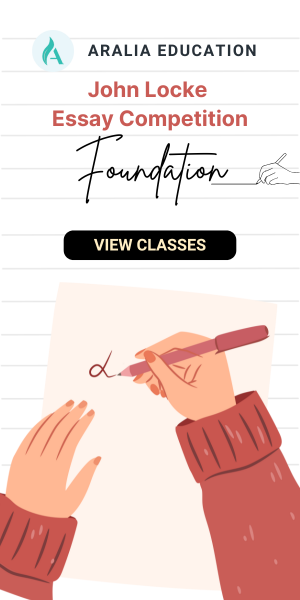There are differences between high school and college writing. While in high school, teachers provide extensive guidelines and rules to guide students throughout the writing process. However, when writing in college, professors don’t generally provide a set structure that students should follow when planning and writing their essays. It is important to unlearn the rules from high school to meet the expectations of university writing. This allows students to be successful in developing strong argumentative writing skills and a more mature style of writing.
1. Essay Structure
High School: In terms of essay structure, high school teachers recommend students to follow the five-paragraph or five-point essay structure including: an introduction, three main points, and a conclusion. The essay begins and ends with something general, with the introduction leading to the discussion of specifics, and then branches out to more general comments at the end. A typical five-paragraph essay normally allows the form to control the content, rather than letting the content control the form. As each paragraph is assigned a purpose, and students are required to fit their content into each and every paragraph. This structure indirectly guides students to limit their analysis to only three main points, leading to an effort to tailor and reduce other important points that might be critical to the development of the essay.
College: For college essay writing, there is no predetermined number of points the essay must include. Since the topics of discussion in college writing are more complex compared to high school essays, students can have as many paragraphs as needed to express their opinions and viewpoints. The reason why five-paragraph essays don’t typically work in college writing is also that they lack flow. The style of listing the arguments allows the writer to treat each paragraph and its main idea as a separate entity, rather than connecting them together while forming an argument. College writing assignments focus on analyzing and interpreting the topic, so the professors will expect you to know the facts and make an argument. This style of writing is vastly different from high school writing.
2. Paragraphs
High School: In high school essays, when the main arguments are narrowed down to specific paragraphs, students are recommended to begin with a topic sentence that reflects the thesis statement and introduces the intended idea. Then, each paragraph should end with a conclusion that reiterates the point in the topic sentence or end with a transitional sentence introducing the next paragraph. The following paragraphs follow a similar structure.
College: Compared to high school essays, college professors expect students to not limit themselves when expressing their ideas. Depending on the idea and evidence provided in the essay, paragraphs can range anywhere from one-third to two-thirds of a page. College writing typically has fewer restrictions on paragraph length and content, because college writing’s sole purpose is to ask students to provide analysis, evidence, highlights, etc., to satisfy their points. The only similarity in paragraphs between high school and college writing is that the beginning of the paragraph comes with a topic sentence that summarizes the main point of the paragraph, then moves on to provide arguments and supporting claims. This new structure in college writing allows for more coherent and clear paragraphs.
However, it’s unusual for college essays to have a concluding sentence in considering the structure. Because college instructors have extensive experience in reading long research papers and complicated essays, students shouldn’t repeat the topic sentence at the end of paragraphs. Instead, students can use this space to complete their evidence and analysis to support the topic. Great writing abilities allow students to complete the analysis and ease the readers to each paragraph, without writing a transition.

3. Thesis statement
High School: As discussed above, in the thesis statement for high school writing, students are strongly encouraged to end the opening paragraph with a thesis statement that should be one sentence in length. There are some nuances between thesis statements and topic sentences; therefore, students normally form a general thesis statement that may resemble a topic sentence. Moreover, the thesis statement should be supported by three main points. A typical example of “listing” of the argument in high school writing is
“I will show how the Romans lost their empire in Britain and Gaul by examining military technology, religion, and politics.” (UNC)
College: In college writing, the opening paragraph can end with a thesis statement, but this is not a hard requirement for college writing. Due to the complexity of topics, the thesis statement isn’t usually supported by three main points, since there can be more than three when discussing the topics covered in the paper. Furthermore, a thesis statement can be two to three sentences long, because it needs to be developed and complex rather than restating the topic sentence. An example of a typical thesis statement seen in college writing is
“The Romans lost their empire in Britain and Gaul because their opponents’ military technology caught up with their own at the same time as religious upheaval and political conflict was weakening the sense of common purpose on the home front”. (UNC)
4. Introduction and Conclusion
High School: Remember when your high school teacher said your introduction should be general and broad to hook the reader in, before narrowing it down to specific points? The teacher may also have said the conclusion should provide a summary of the main points discussed in the paper. This style of writing an introduction and conclusion is quite common in high school, because the teachers are trying to help students think in a more structured and logical way, since you can easily fall into the rabbit hole of discussing arguments that may not be relatable to the topic.
College: However, in college writing, professors prefer you to be straight to the point. Once receiving the writing prompt, students are expected to specify their arguments in concrete terms, rather than just simply paraphrasing the topic and the facts. The conclusion is there for a reason. Rather than summarizing what was earlier in the essay, which the reader is already aware of, students should spend more time refining the conclusion to reflect the topic to a personal story, raise a question of curiosity, or offer important insights for further discussion, etc.
5. Arguments
High School: We’ve seen for argumentative essays, even on the SAT, teachers recommend students to stick to one side or the other when making an argument, in order to best provide examples and evidence to support their claims. The ability to bring up two opposing points and counter argue is challenging for students who did not receive extensive writing training. Additionally, arguments high school students make are frequently based on personal experience or opinion, since they may not know enough about the subject to make a strong and convincing argument.
College: In college, evidence is key. Professors expect a claim that encourages them to keep reading. Argumentative essays should be supported by strong evidence from scholarly and journal sources, as students have spent a considerable amount of time learning about facts and also research sources that support or oppose their arguments. As the legendary engineer Edwards Deming said “’Without data, you’re just another person with an opinion.” In addition to requiring students to provide specific arguments with claims, college professors also expect students to think about “limits and objections to [their] claim” since all interesting claims can be “reasonably challenged.” An essay that addresses counter-arguments along with the supporting arguments is considered strong and persuasive. The University of Chicago’s guide to writing mentions students should think of presenting arguments similar to “an amiable and lively conversation with someone whom you respect and who respects you; someone who is interested in what you have to say, but will not agree with your claims just because you state them; someone who wants to hear your reasons for believing your claims and also wants to hear answers to their questions.”

6. Format
High School: Formatting is required for many high school essays, especially with research or argumentative essays. High school teachers normally introduce the style guide standards such as the MLA and APA, because they are simpler and easier to instruct compared to other style guides.
Style guides are loosely required in high school, because the focus of the essay is to teach students how to form arguments, how to provide evidence, and how to write an easy-to-follow essay. In addition, topics in high school are typically less complicated than in college; therefore, students are not required to do a profound research for understanding the subject matter.
College: However, in college writing, formatting and citations take up a significant amount of the grade for a research paper. Different professors may have different formatting requirements, varying from Chicago to AMA to APA. Otherwise, papers may be marked down if formatting guidelines are not met. Professors will provide this information in the syllabus, or before each research paper project. There are numerous websites and resources online and in your college’s library that will make the citation and formatting process easier and faster, such as Citation Machine.
Students will learn the nuances of language, including figurative language, effective structuring, and specific forms to apply to their own piece(s). Students will work directly with both literary and media texts to plan and write their piece(s). This class will also help the students write with an aim for an audience as their submission for nation-wide and international writing competitions that are timely with the course schedule.
This course helps students develop and improve their writing skills to prepare students for higher education courses. The methodology emphasizes the ability to read critically, think critically, and write critically. Students will learn informative, narrative, descriptive, creative, and persuasive essay writing skills. Students will learn how to brainstorm, structure and outline, form an argument, defend it, incorporate academic sources, and develop a clear, articulate writing style. The focus will be on the writing process, intended audience, consistent tenses, point of view, correct grammar uses, building vocabulary, appropriate style, and proper research and citation protocols.
This course introduces students to significant movements in literary history. The course will begin with a brief introduction to the study of literature. The bulk of the course functions as a survey of literary movements throughout history, focusing primarily on the Western Canon. Students will learn about the history, background of movements like Neoclassicism, Romanticism, Victorian, Realism, Surrealism, etc. Students will reflect on what they are reading through discussion in class, with their teacher and peers, and writing in biweekly assignments.
What's next
How can I improve my writing? 20 Tips to Improve Your Writing
Interested in participating in High School Writing Competitions? There are 27 Writing Competitions for High School Students in 2021!
How can I stand out in writing competitions? The only 5 tips you need to know is here: 5 Tips to Stand Out in a Writing Competition
Heard about John Locke Essay Competition but not sure where to start? Read this Complete Guide to John Locke Essay Competition
Finished your writing work but not sure where to submit it? Where to Submit Your Writing Works: 5 Main Platforms will answer your questions










